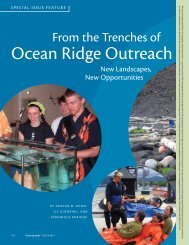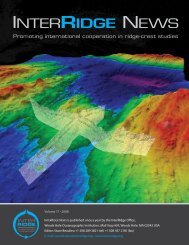Full version, low resolution, 7.5MB - InterRidge
Full version, low resolution, 7.5MB - InterRidge
Full version, low resolution, 7.5MB - InterRidge
You also want an ePaper? Increase the reach of your titles
YUMPU automatically turns print PDFs into web optimized ePapers that Google loves.
National News<br />
Arc systems play an important role in the elemental budget of the<br />
oceans derived from the lithophere (upper mantle, ocean crust and<br />
sediment coverage) and they have become increasingly recognized as<br />
potential resources of metals. Active seafloor hydrothermal systems<br />
pump acidic and extremely metal-rich high temperature fluids into<br />
the ocean that leads to the formation of one of the most extreme<br />
environments of life on earth.<br />
An exceptional example to study an active Au-Co-Ag-rich<br />
hydrothermal system is the Brothers volcanic center, southern<br />
Kermadec arc, located ~400 km north of New Zealand within New<br />
Zealand’s extended economic zone (EEZ).<br />
With a total length of 22,000 km and typically several hydrothermal<br />
vent sites per 100 km, volcanic arcs are as equally important as mid<br />
ocean ridges in overall hydrothermal mass transfer from the<br />
lithosphere to the mantle. In addition, high concentrations of S<br />
species gases, CO 2 and metals can potentially lead to the formation<br />
of ore deposits of different style/type to those discovered along<br />
mid ocean ridges and be host to unknown microbes. The difference<br />
in the style and type of hydrothermal mineralization along arcs is<br />
essentially a result of the different composition and volatile-rich<br />
nature of the host lava, which contributes magmatic vapors<br />
(including metals) through magma degassing in shal<strong>low</strong> magma<br />
reservoirs to the expelled fluids.<br />
Recent investigations of arc hydrothermal vents have provided the<br />
first insights into varied magma-hydrothermal-biological feedback<br />
within the systems, but little is known about subseafloor<br />
mineralization and microbial habitats. Furthermore, knowledge on<br />
the potential to form subseafloor ore deposits on hydrothermally<br />
active volcanoes is entirely lacking.<br />
Drilling of the hydrothermal system of Brothers volcano would<br />
provide missing information about the potential to form subseafloor<br />
mineral deposits and will give new insights into unknown microbial<br />
environments at these volcanoes.<br />
Philippines<br />
Graciano P Yumul, Jr. and Dr. C.B. Dimalanta<br />
The Philippine report is by means of a paper, published in the International Research section of this volume.<br />
Portugal<br />
Pedro Ferreira and Ricardo Santos<br />
From mid-August to mid-October 2012, the Task Group for the<br />
Extension of the Continental Shelf (EMEPC) conducted an<br />
oceanographic cruise aboard the Portuguese Navy Vessel NRP<br />
Almirante Gago Coutinho, to the mid-Atlantic ridge axis and off-axis<br />
area located between the Oceanographer and Hayes fracture zones.<br />
As in previous missions led by the EMEPC, the cruise was<br />
The fol<strong>low</strong>ing are current projects:<br />
characterized by a multidisciplinary approach under the scope of<br />
the extension of the Portugal's continental shelf program. A team<br />
of geology, macro and microbiology, oceanography and geophysics<br />
researchers from several national institutes and universities were onboard<br />
to work in-situ with samples and data collected by the Luso, a<br />
6000 m-rated ROV.<br />
Funded by Portuguese National Science Foundation:<br />
Project Title PI Start Date Duration<br />
DEEPFUN - Biodiversity and functioning of the deep-sea<br />
hydrothermal field Menez Gwen- a contribution to management<br />
policies.<br />
CARCACE - Colonization of mAmmal caRCasses in the deep<br />
Atlantic ocEan<br />
TerRiftic project - unraveling melting processes and volcanism on<br />
the Terceira Rift, Azores: a melting inclusion study.<br />
Ana Colaço (IMAR-<br />
DOP/UAç)<br />
01-04-2011 36 months<br />
Ana Hilario- Cesam<br />
(IMAR-DOP/UAç partner)<br />
01-06-2010 36 months<br />
Filipa Marques- 01-03-2011 36 months<br />
CREMINER<br />
INTERRIDGE NEWS 43 VOL.21, 2012
















